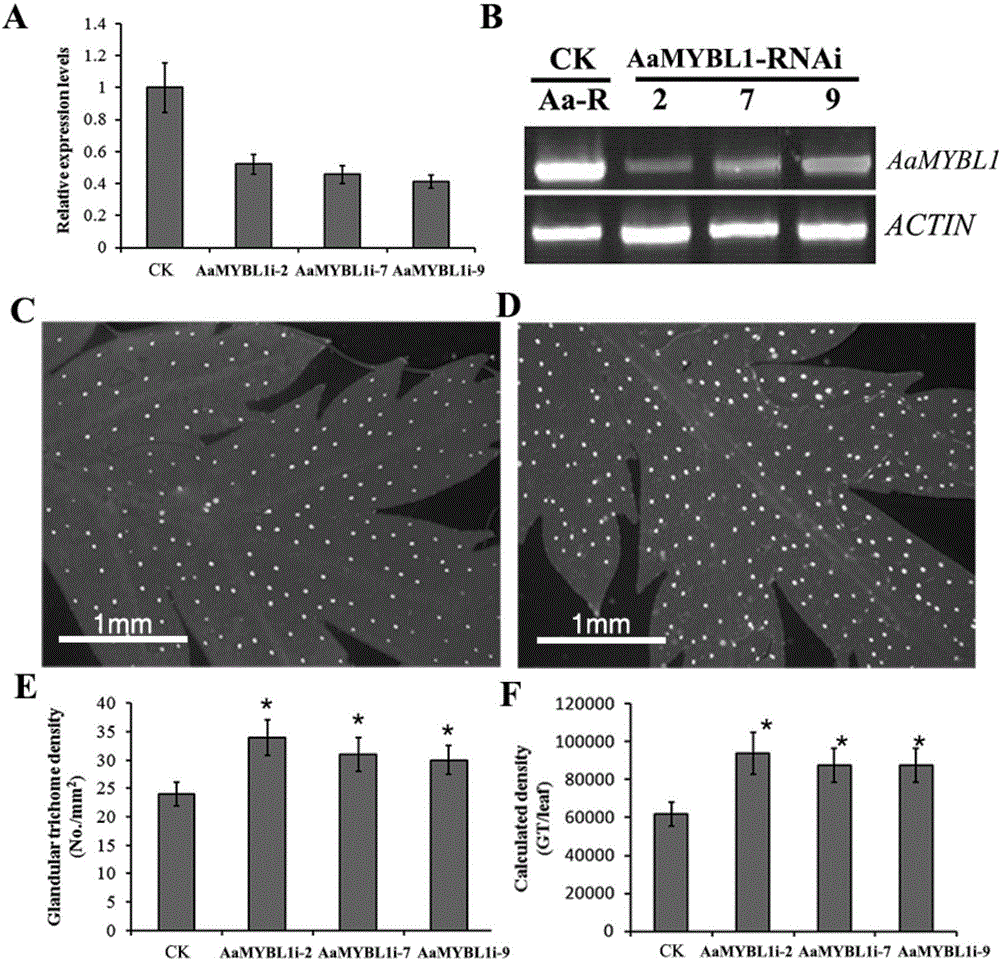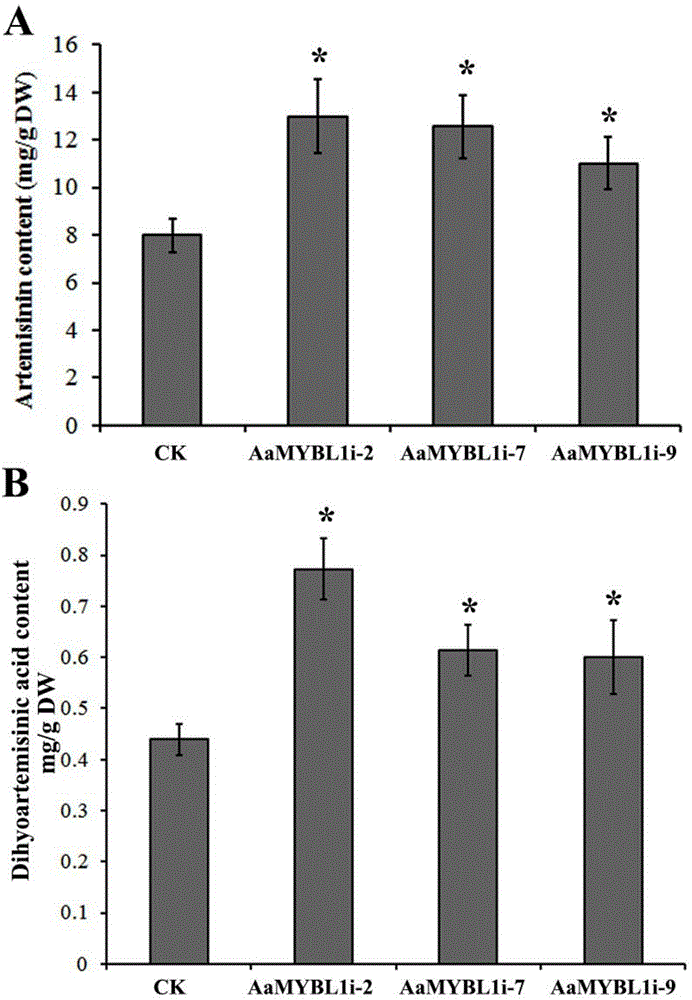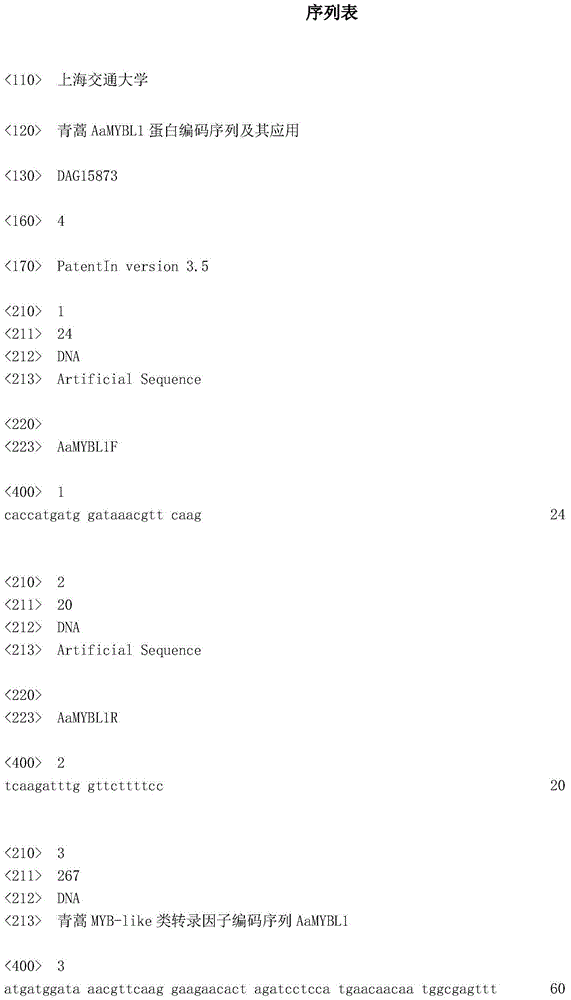Coding sequence of AaMYBL1 protein of artemisia apiacea and application thereof
A coding sequence, Artemisia annua technology, applied in the field of genetic engineering, can solve the problem of not regulating glandular hair density and other problems
- Summary
- Abstract
- Description
- Claims
- Application Information
AI Technical Summary
Problems solved by technology
Method used
Image
Examples
Embodiment 1
[0033] Embodiment 1, the cloning of Artemisia annua AaMYBL1 gene
[0034] 1. Extraction of Total RNA from Artemisia annua Genome
[0035] Take the leaf tissue of Artemisia annua, grind it in liquid nitrogen, add it to a 1.5mL Eppendorf (EP) centrifuge tube filled with lysate, shake it fully, and extract total RNA according to the instructions of the TIANGEN kit. The quality of total RNA was identified by formaldehyde denaturing gel electrophoresis, and then the RNA content was determined on a spectrophotometer.
[0036] 2. Cloning of Artemisia annua AaMYBL1 gene
[0037]Using the extracted total RNA as a template, cDNA was synthesized under the action of PowerScript reverse transcriptase; gene-specific primers (SEQ ID NO: 1 and SEQ ID NO: 2) were designed according to the sequence of the AaMYBL1 gene, and the total cDNA was obtained by PCR. The AaMYBL1 gene was amplified and sequenced.
[0038] Through the above steps, the full-length coding sequence (SEQ ID NO: 3) of the...
Embodiment 2
[0039] Embodiment 2, the construction of the plant binary interference expression vector containing AaMYBL1 gene
[0040] 1. Construction of intermediate vector pENTY-AaMYBL1
[0041] Design upstream primers and downstream primers in the non-conserved region of AaMYBL1 gene to construct interference vectors. Add CACC four bases before the ATG base of the upstream primer to construct the Gateway entry vector. According to Invitrogen pENTR TM / D- The operating steps of the Cloning Kit are to first amplify the AaMYBL1 fragment with flat-end enzyme, recover and purify it, and connect it to the pENTR / D-TOPO vector through Gateway cloning technology.
[0042] 2. Construction of plant expression interference vector pHELLSGATE-AaMYBL1i
[0043] According to Invitrogen LR The operation of the II Enzyme kit is to recombine the interference fragment of AaMYBL1 in the pENTR-AaMYBL1 vector into two recombination sites that can form a hairpin structure in the RNA interference vecto...
Embodiment 3
[0045] Example 3. Agrobacterium tumefaciens-mediated AaMYBL1 interference vector genetically transforms Artemisia annua to obtain transgenic Artemisia annua plants
[0046] 1. Acquisition of Agrobacterium tumefaciens Engineering Bacteria Containing AaMYBL1 Interference Expression Vector
[0047] The plant binary interference expression vector containing AaMYBL1 in Example 2 was transformed into Agrobacterium tumefaciens by freeze-thaw method (such as EHA105, which is a publicly available biological material in the market, which can be purchased from CAMBIA Company in Australia, and the strain number is Gambar1) , and validated by PCR. The results showed that the plant binary interference expression vector containing AaMYBL1 had been successfully constructed into the Agrobacterium tumefaciens strain.
[0048] 2. Agrobacterium tumefaciens mediated AaMYBL1 gene transformation of Artemisia annua
[0049] 2.1. Preculture of explants
[0050] Artemisia annua seeds were soaked i...
PUM
 Login to View More
Login to View More Abstract
Description
Claims
Application Information
 Login to View More
Login to View More - R&D
- Intellectual Property
- Life Sciences
- Materials
- Tech Scout
- Unparalleled Data Quality
- Higher Quality Content
- 60% Fewer Hallucinations
Browse by: Latest US Patents, China's latest patents, Technical Efficacy Thesaurus, Application Domain, Technology Topic, Popular Technical Reports.
© 2025 PatSnap. All rights reserved.Legal|Privacy policy|Modern Slavery Act Transparency Statement|Sitemap|About US| Contact US: help@patsnap.com



